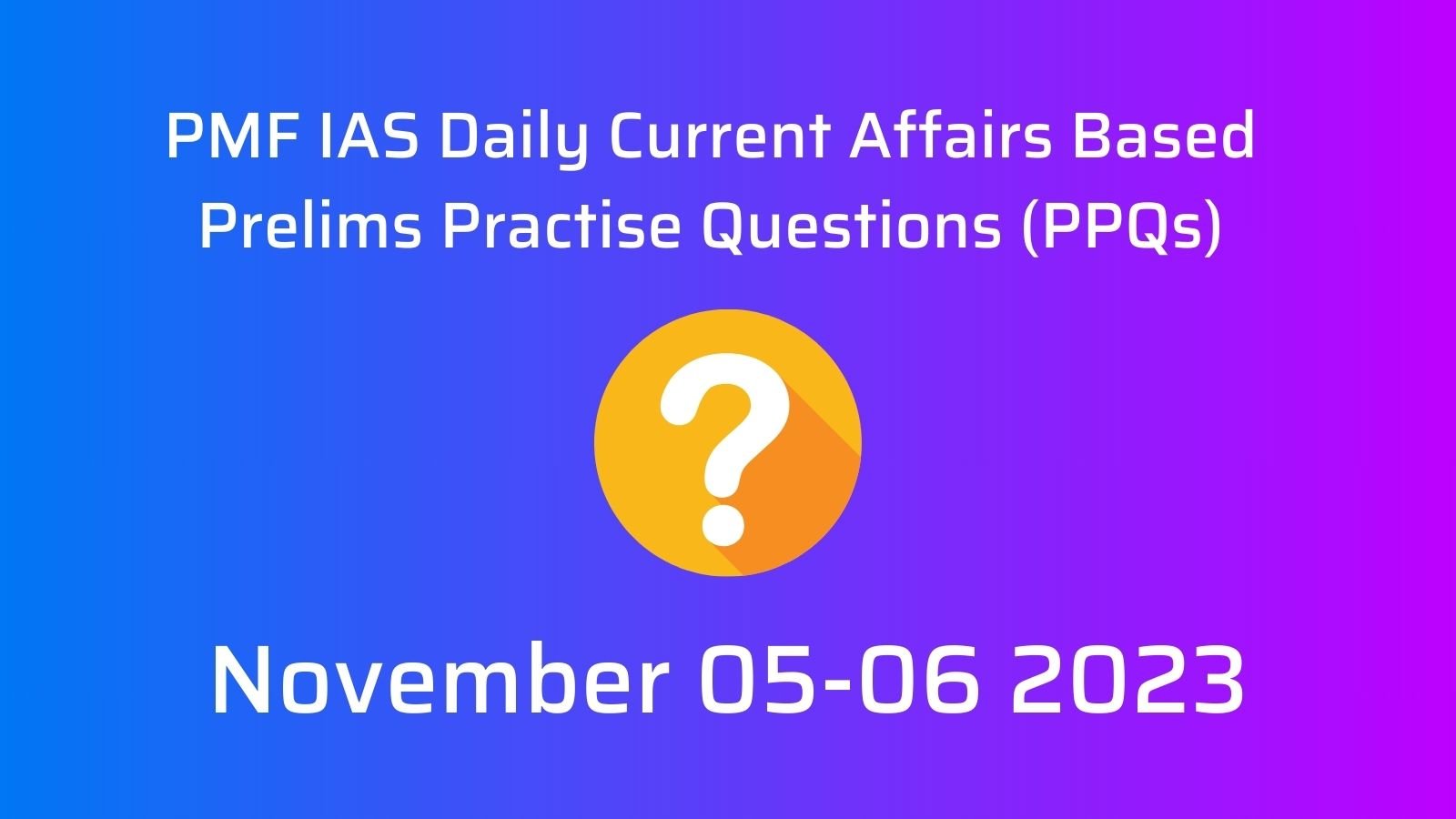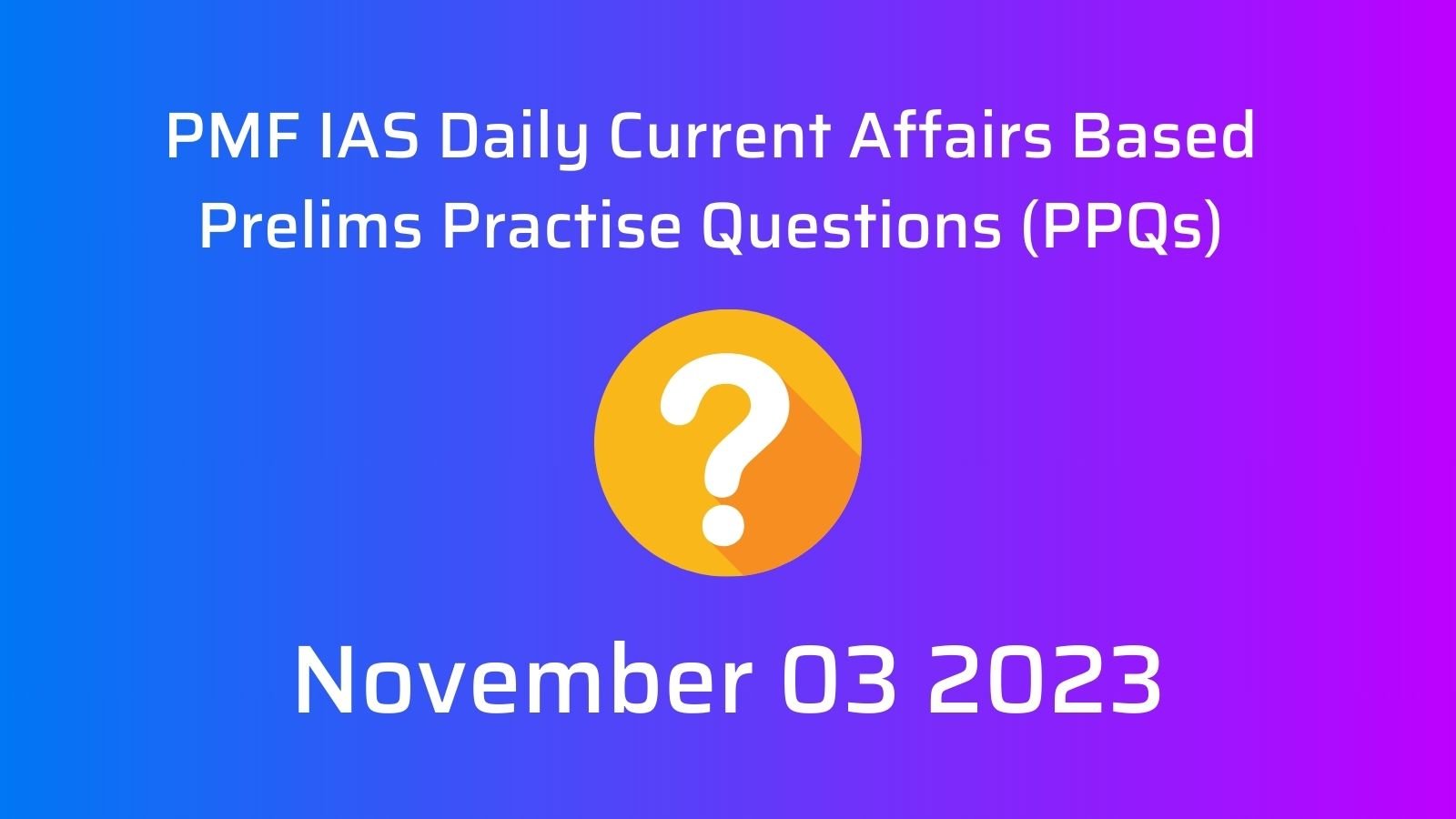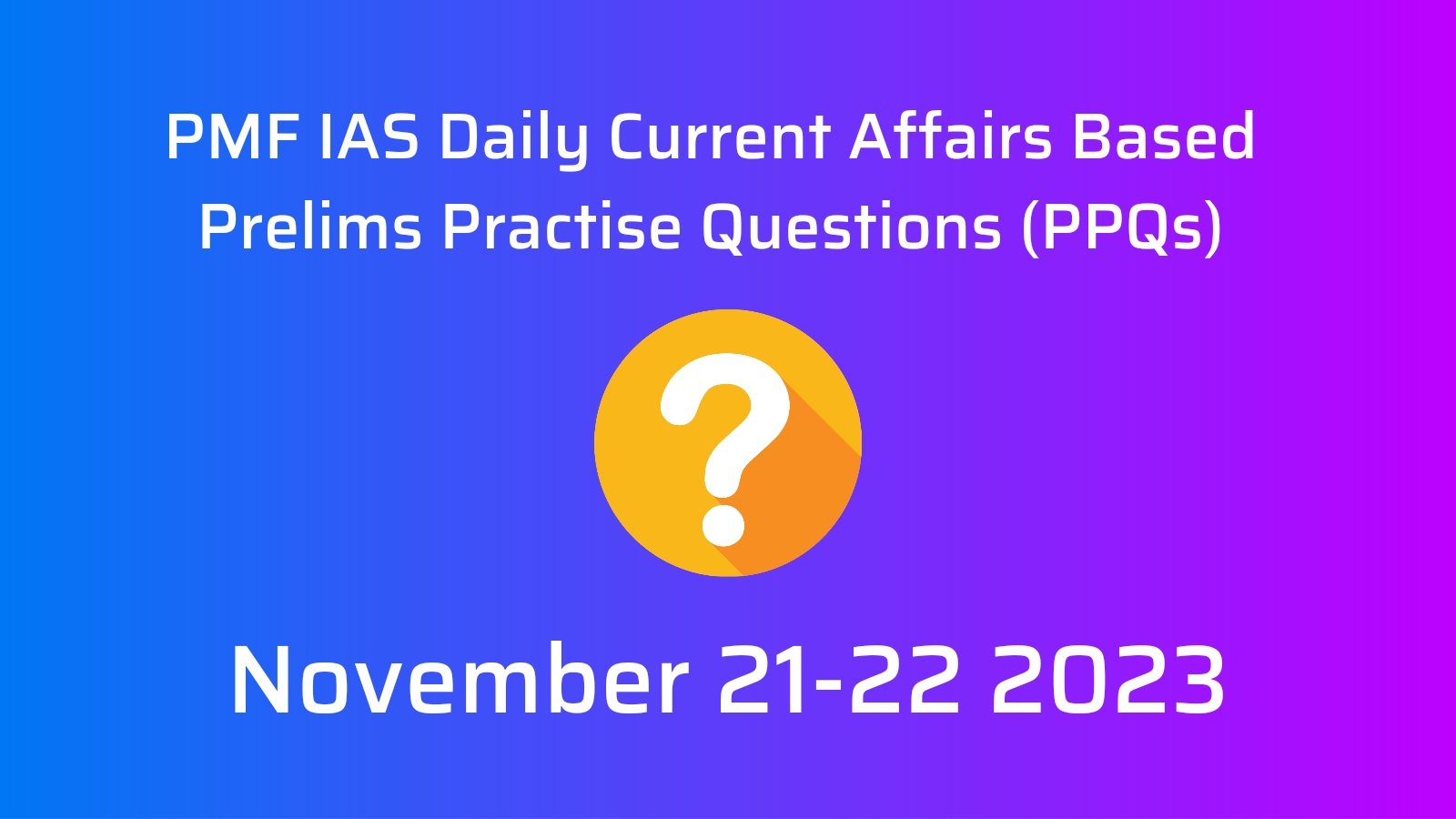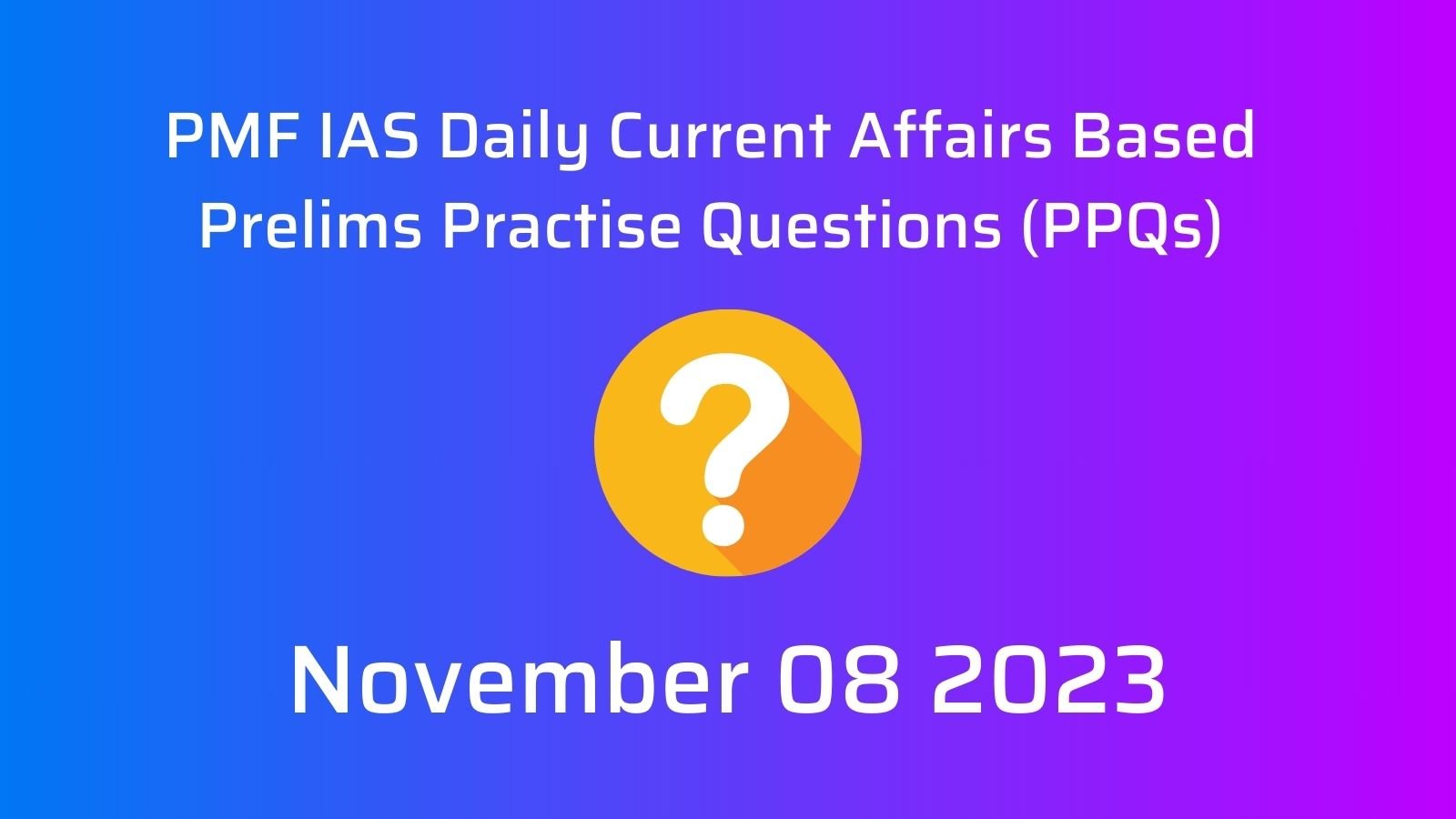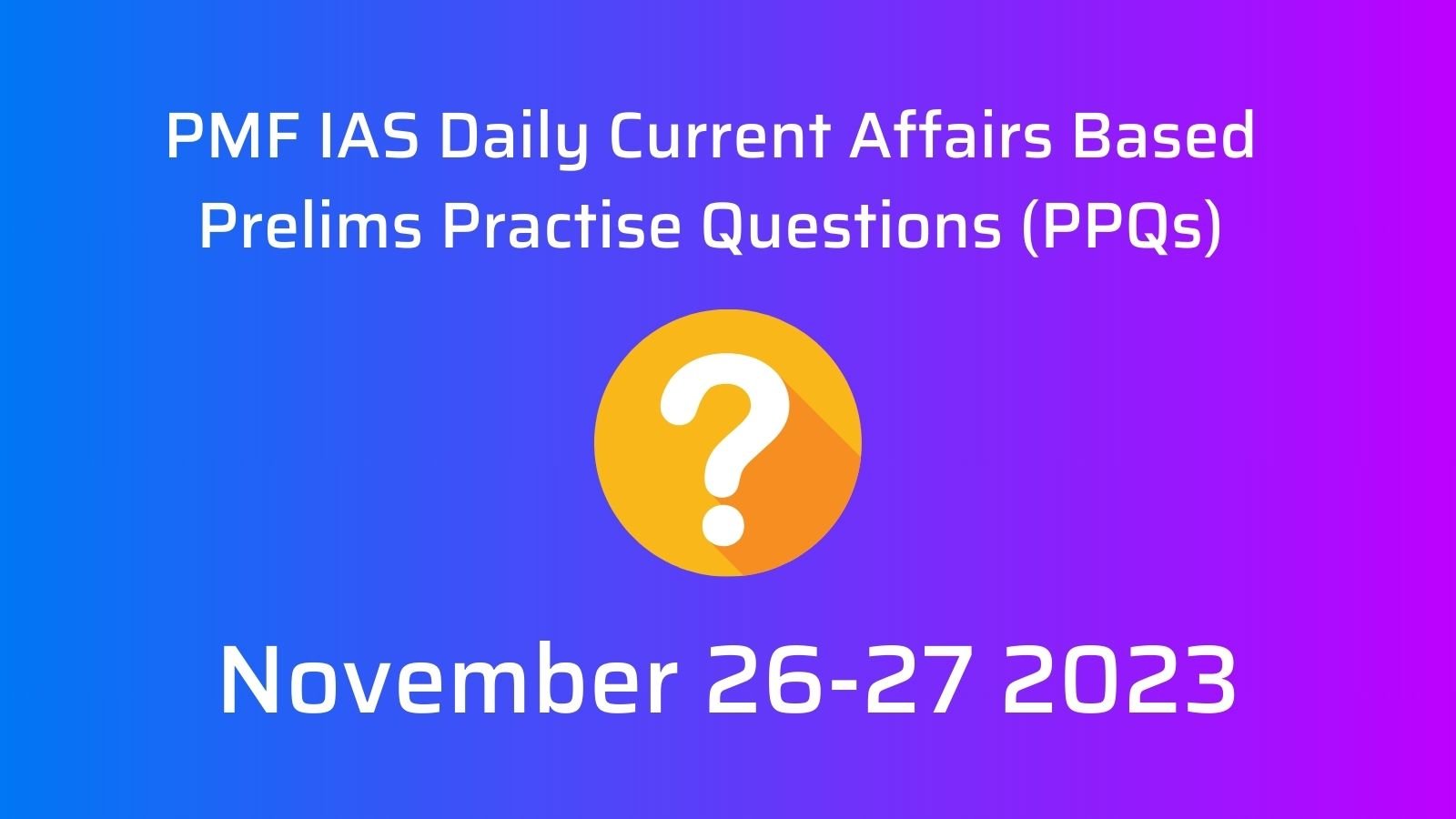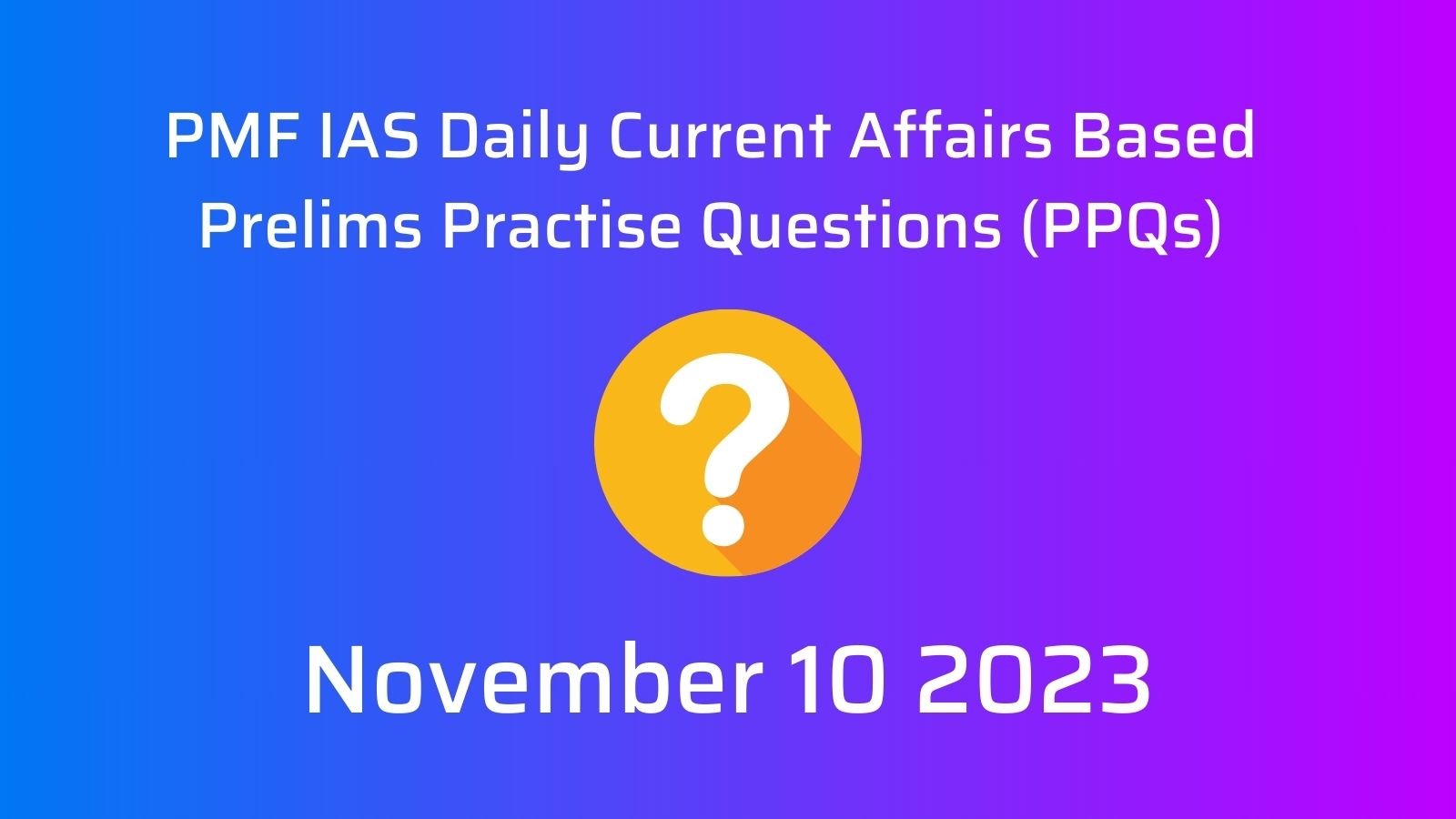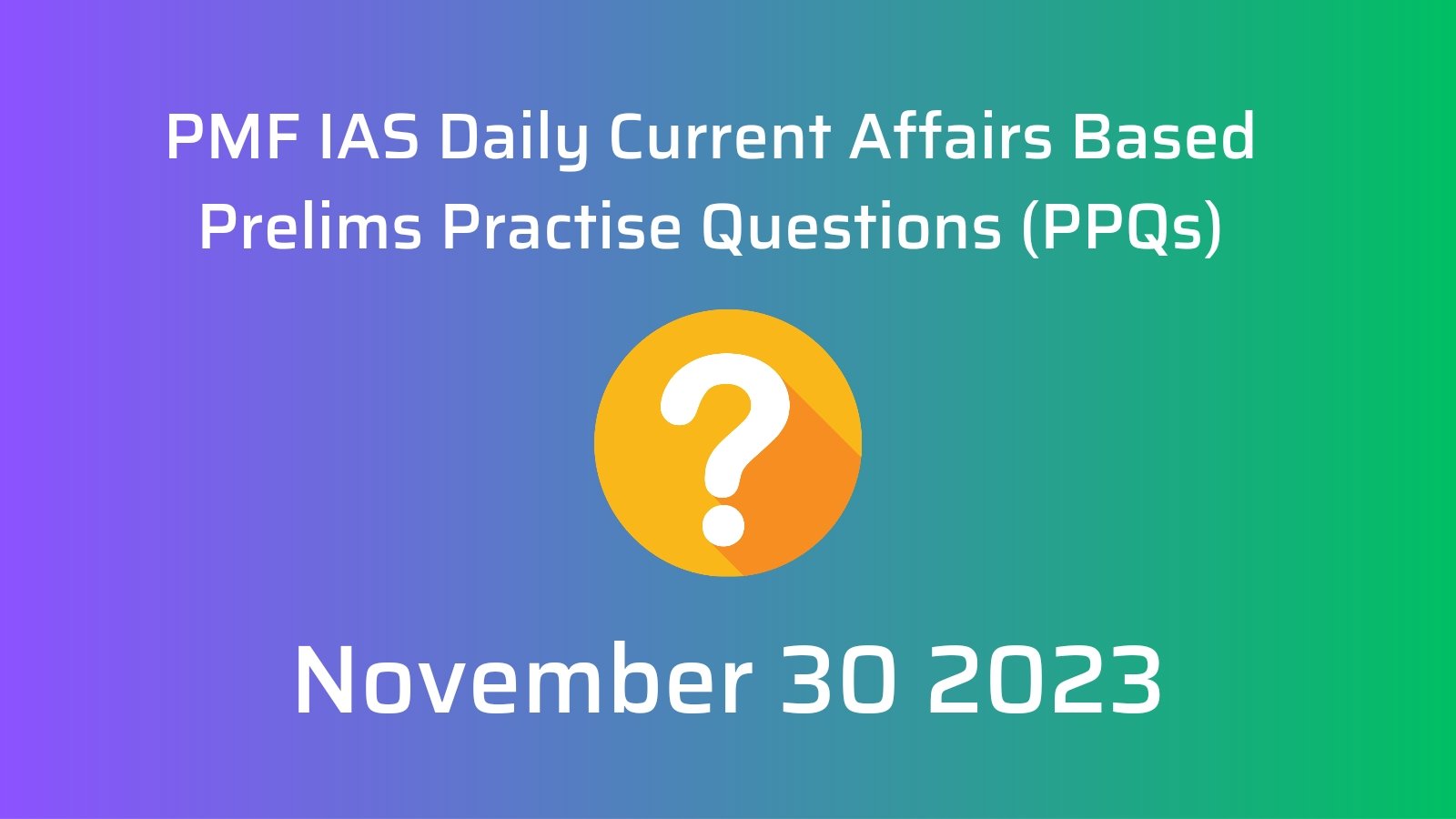
Daily Prelims Practice Questions (PPQs) – November 19-20 2023
Subscribe to Never Miss an Important Update! Assured Discounts on New Products!
Must Join PMF IAS Telegram Channel & PMF IAS History Telegram Channel
Questions
- Below are some questions from PMF IAS Daily Prelims Practice Questions (PPQs) – November 2023
Q1. {IE – Industry} Consider the following statements about the Textile Industry in India:
- Technical textiles are primarily composed of synthetic fibers that are engineered to improve performance.
- National Technical Textiles Mission aims to position the India as a global leader in Technical Textiles.
Which of the above statement(s) is/are correct?
- Both 1 and 2
- 1 only
- 2 only
- Neither 1 nor 2
Q2. {Agri – Crops } Consider the following statements regarding GI Tagging in India:
- India enacted the Geographical Indications of Goods (Registration and Protection) Act, 1999 in order to comply with the obligations to Food and Agricultural Organization.
- The Geographical Indication (GI) Registry, operating under the Department of Agriculture and Farmers’ Welfare, has awarded the GI tag to the Onattukara Vikasana Agency (OVA) , the registered owner of the GI-tagged Onattukara sesame in Kerala.
- The Onattukara Sesame is grown in the Region of Kerala, Tamil Nadu and Karnataka.
Which of the above statement(s) is/are correct?
- Only Two
- Only One
- All Three
- None of these
Q3. {IR – China – Pakistan} Consider the following statements about the CPEC Project:
- This Rail-and-land-based corridor is aimed to secure and reduce the passage for China’s energy imports from the Middle East by avoiding the existing route from the from Yunnan – Karachi.
- India opposes the project on the grounds of sovereignty and transparency. India has boycotted the BRICS Summit hosted by China in 2017 and 2019 as a mark of Protest.
- Partnership for Global Infrastructure and Investment (PGII), promoted by India is seen as the G7’s counter to China’s multi-trillion dollar Belt and Road Initiative (BRI) to build connectivity, infrastructure, and trade projects in Asia, Europe, Africa, and Latin America.
Which of the above statement(s) is/are correct?
- Only One
- Only Two
- Only Three
- None of these
Q4. {AI – Science & Tech} Consider the following statements about the achievements of AI:
- AI Chemist has gotten a breakthrough in the development of a drug which will be used to treat Cancer in later stages.
- Machine Learning and Deep Learning are both Subsets of AI.
- In India, the Judiciary is still out of touch with the latest developments in AI and is lagging behind other organs of government, getting in sync with it.
- DeepBrain AI is used to build a connection with viewers by elevating the training videos using hyper-realistic AI avatars offered by DeepBrain to infuse them with a lifelike quality.
How many of the above statement(s) is/are incorrect?
- Only one
- Only two
- Only three
- All four
Q5. {Governance – Issues} Consider the following statements about Halal Certification in India:
- FAO defines Halal as one that is permitted under the Islamic Law.
- Vegetarian food would be considered permissible or ‘halal’ unless it contains alcohol.
- Halal Certification Agencies in India are regulated under the Food Safety and Standards (LABELLING AND DISPLAY) Regulations, 2020.
- FSSAI is the Official Regulator for the Certification of Halal Products in India.
How many of the above statement(s) is/are Correct ?
- Only two
- Only three
- All Four
- Only One
Q6. {Indian Economy – Currency – Growth and Development} Consider the following statements about the Forex Reserves and it’s Components:
- Forex Reserves serves as a cushion in the event of a Balance of Payment (BoP) crisis on the economic front.
- The Indian forex reserves consist of foreign currency assets, gold, special drawing rights, and the International Monetary Fund (IMF) reserve position.
- IMF members can use SDRs in a range of other authorized operations among themselves. The use of SDRs is Cost Free.
- SDR Allocation is a Loan from the IMF.
How many of the above statement(s) is/are Correct ?
- Only One
- Only Two
- Only Three
- All Four
Questions with Answers and Explanation.
Q1. {IE – Industry} Consider the following statements about the Textile Industry in India:
- Technical textiles are primarily composed of synthetic fibers that are engineered to improve performance.
- National Technical Textiles Mission aims to position the India as a global leader in Technical Textiles.
Which of the above statement(s) is/are correct?
- Both 1 and 2
- 1 only
- 2 only
- Neither 1 nor 2
Explanation
Statement 1 and Statement 2 are correct
- Technical textiles are primarily composed of synthetic fibers that are engineered to improve performance. Synthetic fibers are stronger, more durable, and more resistant to chemicals and abrasion than natural fibers. This makes them ideal for use in a wide variety of applications, including clothing, furniture, medical products, and industrial products.
- Technical textiles are defined as textile materials and products used primarily for their technical performance and functional properties rather than their aesthetic or decorative characteristics. They often serve practical functions in various industries, including healthcare, automotive, aerospace, construction, and sports.
- The National Technical Textiles Mission (NTTM) aims to position India as a global leader in technical textiles. The NTTM was launched in 2020 with the goal of increasing the production and export of technical textiles from India.
Answer: (a) Both 1 and 2
Q2. {Agri – Crops } Consider the following statements regarding GI Tagging in India:
- India enacted the Geographical Indications of Goods (Registration and Protection) Act, 1999 in order to comply with the obligations to Food and Agricultural Organization.
- The Geographical Indication (GI) Registry, operating under the Department of Agriculture and Farmers’ Welfare, has awarded the GI tag to the Onattukara Vikasana Agency (OVA) , the registered owner of the GI-tagged Onattukara sesame in Kerala.
- The Onattukara Sesame is grown in the Region of Kerala, Tamil Nadu and Karnataka.
Which of the above statement(s) is/are correct?
- Only Two
- Only One
- All Three
- None of these
Explanation
Statement 1 is incorrect
- The Food and Agriculture Organization (FAO) is a specialized agency of the United Nations that leads international efforts to defeat hunger.
- With 195 members – 194 countries and the European Union, FAO works in over 130 countries worldwide.
- India enacted the Geographical Indications of Goods (Registration and Protection) Act, 1999 in order to comply with the obligations to WTO.
- The main Agreement under WTO for protection of Geographical Indications is Trade Related Aspects of Intellectual Property Rights (TRIPS) Agreement.
- Government of India enacted Geographical Indications of Goods (Registration and Protection) Act, 1999. This act came into force in September, 2003.
Statement 2 is incorrect
- GI tags are issued as per the Geographical Indications of Goods (Registration and Protection) Act,1999. This tag is issued by the Geographical Indication Registry under the Department of Industry Promotion and Internal Trade, Ministry of Commerce and Industry. Recently, they awarded the GI tag to the Onattukara Vikasana Agency (OVA) , the registered owner of the GI-tagged Onattukara sesame in Kerala.
Statement 3 is correct
- Onattukara sesame is currently grown on around 600 hectares spread across 43 local bodies in three districts of Alappuzha, Kollam and Pathanamthitta.
- Compared to other places, sesame grown in the region contains high levels of Vitamin E and antioxidants. It also contains oleic acid, linoleic acid, palmitoleic acid and so on which help maintain good health.
Answer: (b) Only One
Q3. {IR – China – Pakistan} Consider the following statements about the CPEC Project:
- This Rail-and-land-based corridor is aimed to secure and reduce the passage for China’s energy imports from the Middle East by avoiding the existing route from the from Yunnan – Karachi.
- India opposes the project on the grounds of sovereignty and transparency. India has boycotted the BRICS Summit hosted by China in 2017 and 2019 as a mark of Protest.
- Partnership for Global Infrastructure and Investment (PGII), promoted by India is seen as the G7’s counter to China’s multi-trillion dollar Belt and Road Initiative (BRI) to build connectivity, infrastructure, and trade projects in Asia, Europe, Africa, and Latin America.
Which of the above statement(s) is/are correct?
- Only One
- Only Two
- Only Three
- None of these
Explanation
Statement 1 is incorrect
- CPEC Is a 3000 km Chinese infrastructure network project undertaken in Pakistan.This sea-and-land-based corridor is aimed to secure and reduce the passage for China’s energy imports from the Middle East by avoiding the existing route from the Straits of Malacca between Malaysia and Indonesia.

Statement 2 is incorrect
- India has never boycotted any BRICS Summit since it’s inception in 2009.
Statement 3 is Correct
- The U.S. along with its allies had announced the launch of the Build Back Better World (B3W) in 2021 with the aim of narrowing the 40 trillion dollar infrastructure gap in the developing world. Partnership for Global Infrastructure and Investment is therefore a relaunch of the B3W plan.
- Under the PGII, G7 will mobilize 600 billion dollars by 2027 to deliver “game-changing” and “transparent” infrastructure projects to developing and middle-income countries.
- The European Commission President declared Europe’s pledge of mobilizing 300 billion euros for the partnership over the same period.
- U.S. International Development Finance Corporation (DFC) will invest up to USD 30 million in Omnivore Agritech and Climate Sustainability Fund.
- Climate Sustainability Fund: It is an impact venture capital fund that invests in entrepreneurs building the future of agriculture, food systems, climate, and the rural economy in India.
- Omnivore Agritech: It is a technology driven agricultural practice that will increase agricultural prosperity and transform food systems to make farming more resilient and sustainable.
Answer: (a) Only One
Q4. {AI – Science & Tech} Consider the following statements about the achievements of AI:
- AI Chemist has gotten a breakthrough in the development of a drug which will be used to treat Cancer in later stages.
- Machine Learning and Deep Learning are both Subsets of AI.
- In India, the Judiciary is still out of touch with the latest developments in AI and is lagging behind other organs of government, getting in sync with it.
- DeepBrain AI is used to build a connection with viewers by elevating the training videos using hyper-realistic AI avatars offered by DeepBrain to infuse them with a lifelike quality.
How many of the above statement(s) is/are incorrect?
- Only one
- Only two
- Only three
- All four
Explanation
Statement 1 is incorrect
- A team from the University of Science and Technology of China (USTC) at the Chinese Academy of Sciences (CAS) has developed a robotic AI chemist.
- It is capable of automatically synthesizing and optimizing catalysts from Martian meteorites
- Operating under unmanned conditions, the AI chemist produced an exceptional catalyst using five types of Martian meteorites. In a further test at -37 degrees Celsius, Mars’s temperature, the catalyst consistently produced oxygen without any apparent degradation
Statement 2 is incorrect
- Machine Learning is a subset of AI that involves the development of algorithms that allow computers to learn from data without being explicitly programmed.
- DL is a subset of ML that uses artificial neural networks to learn from data in a way that is similar to how the human brain learns.
Statement 3 is incorrect
- Indian Judiciary is at the dawn Modernization and Digitalisation, and is successfully powering through the Use of AI.
- SUVAS (Supreme Court Vidhik Anuvaad Software): It is an AI system that can assist in the translation of judgments into regional languages.
- This is another landmark effort to increase access to justice.
- SUPACE (Supreme Court Portal for Assistance in Court Efficiency): It was recently launched by the Supreme Court of India.
Statement 4 is correct
- DeepBrain AI has proven its world-class conversational artificial intelligence technology to be highly utilized in many areas, including broadcasting, education, and in service industry.
- Enables anomaly detection in manufacturing processes, optimizing quality control, and reducing defects through AI-powered analysis.
- AI technology in DeepBrain helps in financial forecasting by analyzing market trends and supporting more informed investment decisions.
Answer: (c) Only three
Q5. {Governance – Issues} Consider the following statements about Halal Certification in India:
- FAO defines Halal as one that is permitted under the Islamic Law.
- Vegetarian food would be considered permissible or ‘halal’ unless it contains alcohol.
- Halal Certification Agencies in India are regulated under the Food Safety and Standards (LABELLING AND DISPLAY) Regulations, 2020.
- FSSAI is the Official Regulator for the Certification of Halal Products in India.
How many of the above statement(s) is/are Correct ?
- Only two
- Only three
- All Four
- Only One
Explanation
Statement 1 is correct
- Halal is an Arabic word that translates to ‘permissible’ in English.
- FAO defines Halal as one that is permitted under the Islamic Law.
- The term halal is mainly associated with Islamic dietary laws, referring to food procured, processed, and traded in compliance with Islamic belief.
Statement 2 is Correct
- Despite its widespread usage for meat products, halal does not have to do with meat.
- So vegetarian food would be considered permissible or ‘halal’ unless it contains alcohol.
Statement 3 is incorrect
- The GoI neither mandates halal certification nor does it provide a unifying regulatory law.
- There are multiple halal certifying agencies that grant halal certifications to companies, products, or food establishments.
Statement 4 is incorrect
- India does not have an official regulator for the certification of halal products.
- The FSSAI is headed by a non-executive chairperson, appointed by the central government, either holding or has held the position of not below the rank of Secretary to the Government of India.
Answer: (a) Only Two
Q6. {Indian Economy – Currency – Growth and Development} Consider the following statements about the Forex Reserves and it’s Components:
- Forex Reserves serves as a cushion in the event of a Balance of Payment (BoP) crisis on the economic front.
- The Indian forex reserves consist of foreign currency assets, gold, special drawing rights, and the International Monetary Fund (IMF) reserve position.
- IMF members can use SDRs in a range of other authorized operations among themselves. The use of SDRs is Cost Free.
- SDR Allocation is a Loan from the IMF.
How many of the above statement(s) is/are Correct ?
- Only One
- Only Two
- Only Three
- All Four
Explanation
Statement 1 is Correct
- Comfortable Position for the Government: The rising forex reserves give comfort to the government and the RBI in managing India’s external and internal financial issues.
- Managing Crisis: It serves as a cushion in the event of a Balance of Payment (BoP) crisis on the economic front.
Statement 2 is correct
- The main elements of forex reserves in India include foreign currencies, gold reserves, special drawing rights, and the reserve portion in IMF.
- The reserve portion in the IMF represents India’s quota in the International Monetary Fund. It reflects India’s position and voting power within this global financial institution.
- Gold reserves are another essential component of Indian forex reserves. Gold is a hedge against inflation and provides a safety net during economic uncertainties.
- The foreign currencies reserve is the most significant component of the Indian forex reserves. It includes major currencies like the US Dollar, the Euro, and the British Pound. Holding these currencies provides liquidity and enables the country to pay for international trade transactions.
Statement 3 is incorrect
- IMF members can also use SDRs in a range of other authorized operations among themselves (e.g. loans, payment of obligations, pledges) and in operations and transactions involving the IMF, such as the payment of interest on and repayment of loans, or payment for quota increases.
- An SDR allocation is ‘cost-free’ for all members because charges and interest net out to zero if the countries do not use their SDR allocations.
- The use of SDRs is not ‘cost free’. The use of SDRs occurs when a country reduces its SDR holdings vis-à-vis its cumulative SDR allocation. Countries that exchange their SDRs for currency will incur net charges on the difference between their cumulative SDR allocations and their SDR holdings.
Statement 4 is incorrect
- The Special Drawing Right (SDR) allocation is not a loan from the IMF. When the IMF allocates SDRs, participants in the SDR Department receive unconditional liquidity represented by an interest-bearing reserve asset (SDR holding) and a corresponding long-term liability to the SDR Department (SDR allocation).




![PMF IAS Environment for UPSC 2022-23 [paperback] PMF IAS [Nov 30, 2021]…](https://pmfias.b-cdn.net/wp-content/uploads/2024/04/pmfiasenvironmentforupsc2022-23paperbackpmfiasnov302021.jpg)
